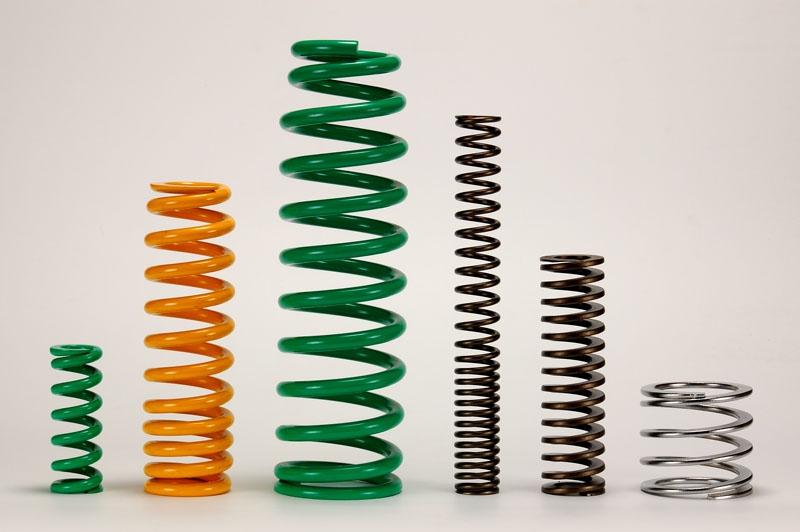Hardware spring
A mechanical part that uses its own deformation to generate force or store energy.

Its main functions are:
1.control the movement of machinery, such as valve spring in internal combustion engine, control spring in clutch, etc. 2.Absorb vibration and impact energy, such as buffer spring under automobile and train carriage, vibration absorbing spring in coupling, etc.
3. Store and output energy as power, such as clock spring, spring in firearms, etc. ④ Used as force measuring element, such as force measuring device, spring in spring scale, etc. The ratio of spring load to deformation is called spring stiffness. The greater the stiffness, the harder the spring.
According to the stress nature, the spring can be divided into tension spring, compression spring, torsion spring and bending spring. According to the shape, it can be divided into coil spring, disc spring, ring spring, plate spring, plane volute spring and torsion bar spring. Ordinary cylindrical coil spring is widely used because of its simple manufacture, various types can be made according to the load conditions and simple structure.
Generally speaking, the manufacturing materials of springs should have high elastic limit, fatigue limit, impact toughness and good heat treatment performance. Commonly used are carbon spring steel, alloy spring steel, stainless spring steel, copper alloy, nickel alloy and rubber. The manufacturing methods of spring include cold coil method and hot coil method. The spring wire with diameter less than 8mm is generally cold rolled, and the spring wire with diameter greater than 8mm is hot rolled. Some springs must be subjected to strong pressure or shot peening after being made, which can improve the bearing capacity of the spring.
Spring is an elastic element widely used in mechanical and electronic industries. When loaded, the spring can produce large elastic deformation and convert mechanical work or kinetic energy into deformation energy. After unloading, the deformation of the spring disappears and returns to the original state, and the deformation energy is converted into mechanical work or kinetic energy.
The main functions of the spring are:
1. force measurement, such as the spring of spring scale and measuring meter;
2.Control movement, such as clutch, brake and valve control spring;
3.Vibration reduction and buffer, such as buffer, spring of shock absorber, etc;
4.Energy storage or transmission, such as clocks, meters and springs on automatic control mechanisms.
Types of springs: there are many types of springs, including compression spring, tension spring, torsion spring and wire forming.
Name and dimension relationship of each part of spring:
(1) On the diameter of spring wire D: the diameter of steel wire for manufacturing spring.
(2) Spring outer diameter D: the maximum outer diameter of the spring.
(3) Spring inner diameter D1: the minimum outer diameter of the spring.
(4) Spring pitch diameter D2: the average diameter of the spring. Their calculation formula is: D2 = (D + D1) ÷ 2 = D1 + D = d-d
(5) T: except for the support ring, the axial distance between the corresponding points of the two adjacent rings of the spring on the pitch diameter becomes the pitch, which is expressed by T.
(6) Effective number of turns n: the number of turns that the spring can maintain the same pitch.
(7) Number of support rings N2: in order to make the spring bear uniform force during operation and ensure that the axis is perpendicular to the end face, both ends of the spring are often tightened together during manufacturing. The number of tight turns only plays a supporting role, which is called the supporting ring. There are generally 1.5T, 2T and 2.5t, and 2T is commonly used.
(8) Total turns N1: sum of effective turns and support turns. That is N1 = n + N2
(9) Free height H0: the height of the spring without external force. Calculated by the following formula: H0 = NT + (n2-0.5) d = NT + 1.5D (when N2 = 2)
(10) Spring unfolding length L: the length of steel wire required for winding the spring. L≈n1 ( Л D2) 2 + N2 (compression spring) l= Л D2 n + unfolded length of hook (tension spring)
(11) Spiral direction: it can be divided into left and right rotation. It is usually right rotation. If it is not indicated in the drawing, it is generally right rotation.
Specified drawing method of spring:
(1) On the view parallel to the coil spring line, the contour line of each circle is drawn as a straight line.
(2) For springs with more than 4 effective turns, only 1 ~ 2 turns at both ends (excluding support rings) can be drawn. The middle is connected with a dotted line through the center of the spring steel wire.
(3) In the drawing, when the rotation direction of the spring is not specified, the coil spring shall be painted as right rotation, and the left rotation spring shall also be painted as right rotation, but the word “left” shall be indicated.






